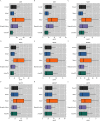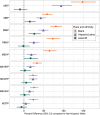Racial and Ethnic Disparities in Phthalate Exposure and Preterm Birth: A Pooled Study of Sixteen U.S. Cohorts
- PMID: 38117586
- PMCID: PMC10732302
- DOI: 10.1289/EHP12831
Racial and Ethnic Disparities in Phthalate Exposure and Preterm Birth: A Pooled Study of Sixteen U.S. Cohorts
Abstract
Background: Phthalate exposures are ubiquitous during pregnancy and may contribute to racial and ethnic disparities in preterm birth.
Objectives: We investigated race and ethnicity in the relationship between biomarkers of phthalate exposure and preterm birth by examining: a) how hypothetical reductions in racial and ethnic disparities in phthalate metabolites might reduce the probability of preterm birth; and b) exposure-response models stratified by race and ethnicity.
Methods: We pooled individual-level data on 6,045 pregnancies from 16 U.S. cohorts. We investigated covariate-adjusted differences in nine urinary phthalate metabolite concentrations by race and ethnicity [non-Hispanic White (White, 43%), non-Hispanic Black (Black, 13%), Hispanic/Latina (38%), and Asian/Pacific Islander (3%)]. Using g-computation, we estimated changes in the probability of preterm birth under hypothetical interventions to eliminate disparities in levels of urinary phthalate metabolites by proportionally lowering average concentrations in Black and Hispanic/Latina participants to be approximately equal to the averages in White participants. We also used race and ethnicity-stratified logistic regression to characterize associations between phthalate metabolites and preterm birth.
Results: In comparison with concentrations among White participants, adjusted mean phthalate metabolite concentrations were consistently higher among Black and Hispanic/Latina participants by 23%-148% and 4%-94%, respectively. Asian/Pacific Islander participants had metabolite levels that were similar to those of White participants. Hypothetical interventions to reduce disparities in metabolite mixtures were associated with lower probabilities of preterm birth for Black [13% relative reduction; 95% confidence interval (CI): , 8.6%] and Hispanic/Latina (9% relative reduction; 95% CI: , 0.8%) participants. Odds ratios for preterm birth in association with phthalate metabolites demonstrated heterogeneity by race and ethnicity for two individual metabolites (mono-n-butyl and monoisobutyl phthalate), with positive associations that were larger in magnitude observed among Black or Hispanic/Latina participants.
Conclusions: Phthalate metabolite concentrations differed substantially by race and ethnicity. Our results show hypothetical interventions to reduce population-level racial and ethnic disparities in biomarkers of phthalate exposure could potentially reduce the probability of preterm birth. https://doi.org/10.1289/EHP12831.
Figures






References
-
- National Center for Health Statistics. 2022. Births: Provisional Data for 2021. Hyattsville, MD: National Center for Health Statistics.
-
- 'Driscoll AO, Hamilton BE, Valenzuela CP, Martin JA. Quarterly Provisional Estimates for Selected Birth Indicators, Quarter 1, 2020–Quarter 1, 2022. https://www.cdc.gov/nchs/nvss/vsrr/natality-dashboard.htm [accessed 1 November 2022].
-
- Braveman P, Dominguez TP, Burke W, Dolan SM, Stevenson DK, Jackson FM, et al. . 2021. Explaining the Black-White disparity in preterm birth: a consensus statement from a multi-disciplinary scientific work group convened by the March of Dimes. Front Reprod Health 3:684207, PMID: , 10.3389/frph.2021.684207. - DOI - PMC - PubMed
Publication types
MeSH terms
Substances
Grants and funding
- P30 ES010126/ES/NIEHS NIH HHS/United States
- P01 ES009584/ES/NIEHS NIH HHS/United States
- R01 DK076648/DK/NIDDK NIH HHS/United States
- T32 ES007018/ES/NIEHS NIH HHS/United States
- U24 ES028533/ES/NIEHS NIH HHS/United States
- P30 ES005022/ES/NIEHS NIH HHS/United States
- P01 ES011261/ES/NIEHS NIH HHS/United States
- R21 HD058019/HD/NICHD NIH HHS/United States
- R01 ES008977/ES/NIEHS NIH HHS/United States
- R01 ES013543/ES/NIEHS NIH HHS/United States
- P30 ES023513/ES/NIEHS NIH HHS/United States
- P01 ES022844/ES/NIEHS NIH HHS/United States
- R21 ES031231/ES/NIEHS NIH HHS/United States
- R01 ES031591/ES/NIEHS NIH HHS/United States
- UH3 OD023251/OD/NIH HHS/United States
- R01 ES016863/ES/NIEHS NIH HHS/United States
- R01 ES022934/ES/NIEHS NIH HHS/United States
- R21 ES025551/ES/NIEHS NIH HHS/United States
- P42 ES017198/ES/NIEHS NIH HHS/United States
- R01 ES030078/ES/NIEHS NIH HHS/United States
- R24 ES028529/ES/NIEHS NIH HHS/United States
- P30 ES000002/ES/NIEHS NIH HHS/United States
- R01 ES009718/ES/NIEHS NIH HHS/United States
- R01 ES021369/ES/NIEHS NIH HHS/United States
- R01 ES014393/ES/NIEHS NIH HHS/United States
- ZIA ES103321/ImNIH/Intramural NIH HHS/United States
- U24 ES028529/ES/NIEHS NIH HHS/United States
- P30 ES017885/ES/NIEHS NIH HHS/United States
- UH3 OD023342/OD/NIH HHS/United States
- R01 ES031657/ES/NIEHS NIH HHS/United States
- P01 ES009605/ES/NIEHS NIH HHS/United States
- R21 CA128382/CA/NCI NIH HHS/United States
- UL1 TR001881/TR/NCATS NIH HHS/United States
- R01 ES024381/ES/NIEHS NIH HHS/United States
- R24 ES028533/ES/NIEHS NIH HHS/United States
- UH3 OD023365/OD/NIH HHS/United States

